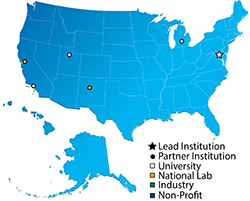Nanostructures for Electrical Energy Storage (NEES)

Director
Gary Rubloff
Lead Institution
University of Maryland
Class
2009-2020
Mission
To reveal scientific insights and design principles that enable a next-generation electrical energy storage technology based on dense mesoscale architectures of multifunctional solid state nanostructures.
Research Topics
catalysis (heterogeneous), bio-inspired, electrical energy storage, defects, mechanical behavior, corrosion, charge transport, quantum information science, mesoscale science, materials and chemistry by design, mesostructured materials, synthesis (novel materials), synthesis (self-assembly), synthesis (scalable processing)
Materials Studied
Materials: semiconductor, wide band-gap semiconductor, metal, oxide, polymer, ceramic, electrolytes, ionic liquid, porous
Interfaces: organic/inorganic, inorganic/inorganic, gas/liquid, gas/solid, liquid/solid, solid/solid
Nanostructured Materials: 0D, 1D, 2D, 3D
Experimental and Theoretical Methods
X-ray diffraction and scattering, X-ray imaging, X-ray spectroscopy, neutron diffraction and scattering, neutron spectroscopy, electron microscopy, scanning probe microscopy, near-field microscopy, surface science, molecular dynamics (MD), density functional theory (DFT), monte carlo (MC), finite element methods, continuum modeling, mesoscale modeling, multiscale modeling

Partner Institutions
- Michigan State University
- Sandia National Laboratories
- University of California, Los Angeles
- University of Maryland
- University of Utah













